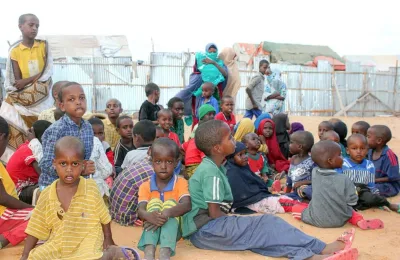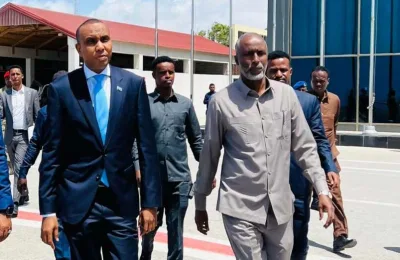Ahead of us blue flashing lights, a rudimentary police cordon and a crowd of residents. We…

Ahead of us blue flashing lights, a rudimentary police cordon and a crowd of residents. We move in. Mindful not to step on the puddles of blood and scraps of flesh scattered across the road.
Two police officers and two suicide bombers dead outside Pangani police station in Nairobi. Some of their remains trapped in the metal skeleton of a car. One former officer tells us “this is al-Shabab. There’ll be no investigation”.
Then chaos. People run for cover as police carry out a controlled explosion on a second device. A fire engine arrives driving through the cordon, none of the evidence is secure. How could there ever be an investigation?
A man in white overalls walks out of the bushes. He’s carrying a football. Then the grim reality passes over us. It’s a human head. He gently places it on the ground as a man’s leg is pulled from the car. This is what Kenya is dealing with on a weekly basis.
That attack took place in a suburb of Nairobi called Eastleigh on 23 April. It’s a Somali Muslim area and has been under intense scrutiny from security services since Kenya’s invasion of Somalia in 2011. That’s when the al-Shabab attacks began.
Operation Usalama
Every night overhead a police helicopter and a military chopper circle Eastleigh. It’s a reminder to the community that they are being watched. The state doesn’t want them to become terrorists. If they do get involved with Shabab, the state wants them to think they will be dealt with.
They call it Operation Usalama. On the ground people live in fear of the security services. Allegations of beatings, assaults and mass arrests have surfaced. Human rights groups and the UN say they are disturbed by this policy of intimidation.
Makaburi ‘elimination’
Nobody is more under pressure from the security services than Abubaker Shariff Ahmed or “Makaburi”. When we met him in November 2013 he expressed his fears of the police saying: “I’m the one being terrorised. My life is the one which is in danger”.
He was right.
In April he was gunned down, allegedly by police. Of course, the government vehemently denies that an extrajudicial killing programme exists. But the officers we spoke to from the GSU Radiation Unit, GSU Recce Company, ATPU and NSIS were candid in their confession.
They described to us how they would carry out surveillance on Makaburi how they would watch him what they would learn about him, his associates and his routines all this in order to carry out a hit.
The ‘elimination programme’
The justification for killing Makaburi is laid out in ink on the confidential police documents we were leaked. In those security briefs was intelligence, which may have been provided by the West, which ultimately drives Kenya’s extrajudicial killing programme. Makaburi was a “financier” and “leader” of al-Shabab in Kenya, according to those reports.
Some of the officers we met said they were proud to “eliminate” such people. This is their job. They are protecting millions of Kenyan citizens. They are just following government orders.
Others told us they understood the policy is wrong. Freely admitting they are part of an elimination programme they disagree with, yet too afraid to leave the service in protest, for fear of being killed themselves.
Killing with impunity
No wonder then, when you talk to ordinary Kenyan citizens, you understand the absurdity of the assassination policy.
We visited the families of five young people in the mountain town of Nyeri, north of Nairobi. The four boys and a barmaid had been brutally killed in April. The girl was hanging from a tree in a forest, with the four boys shot dead by her feet.
We took the families to that site in Tagwa forest. Surrounded by the lush green beauty of the Kenyan highlands, it was an emotional reunion.
Security sources in the media claimed the youngsters were al-Shabab members. The families say the authorities used this story to cover up the extrajudicial killings of their children. They claim none of the youths had even been to Somalia, let alone were al-Shabab militants. They want to know why their children were killed.
‘Blanket cover’
Incidents like the Nyeri case carry with them the most disturbing concern of all. Not only are Kenyans under threat from al-Shabab terror attacks, they are equally in danger of being the victims of the state, as part of its War on Terror.
As one eminent professor of African history told us, “that blanket cover excuses any explanation at all and it’s a very dangerous thing for ordinary citizens”.
The question it leaves us with is this: If the objective of the counter-terror strategy is to make Kenyans safer, is it working? The killing of 64 innocent civilians by al Shabaab in Kenya last week would suggest it isn’t.







